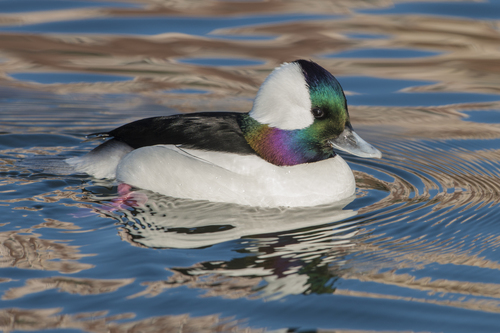
Bufflehead
The Bufflehead (*Bucephala albeola*) is a small, striking sea duck found in North America. It is known for its distinctive appearance, with males exhibiting a large, puffy head that gives the species its name, and its energetic diving behavior. Buffleheads play an important role in their ecosystems as both predator and prey, consuming aquatic invertebrates and serving as food for larger predators. They are not typically associated with significant cultural importance, though their beauty and unique behavior make them a favorite among birdwatchers.
32-40 cm
Length
50-56 cm
Wingspan
Least Concern
Conservation Status
Distribution
Buffleheads breed primarily in Canada and Alaska, extending into parts of the northern United States. During winter, they migrate south throughout the United States and into northern Mexico. They are rarely recorded in western Europe. Their migratory routes often follow coastlines and major river systems.
Lifespan
Average lifespan in the wild is estimated at 2.5 years, but individuals can live up to 18 years.
Bufflehead's Habitat
Habitat Types
Wooded lakes and ponds, Boreal forests, Coastal bays and estuaries, Reservoirs
Climate Zones
Temperate, Boreal
Adaptations
Buffleheads are cavity nesters, almost exclusively using old Northern Flicker or Pileated Woodpecker holes. Their small size allows them to utilize these smaller cavities, reducing competition with larger ducks. They are excellent divers, with streamlined bodies and powerful legs for underwater propulsion.
Variations
No recognized subspecies exist.
Appearance
Breeding Plumage
Breeding males have a striking black and white pattern with a large white patch on their iridescent, puffy head. Females and non-breeding males are more subdued, with grayish-brown bodies and a smaller white cheek patch.
Seasonal Feather Changes
Males undergo a complete molt after breeding, adopting a more female-like plumage (eclipse plumage) before molting again into their breeding plumage.
Sex Based Plumage Differences
Significant. Males are much more brightly colored during breeding season.
Notable Features
Large, puffy head (especially in males), White cheek patch (both sexes), Small, compact body, Rapid wingbeats in flight
Diet and Feeding
Primary Foods
Aquatic invertebrates, Crustaceans, Mollusks, Insect larvae, Small fish, Seeds (during winter)
Foraging Behavior
Buffleheads are diving ducks, typically foraging in relatively shallow water. They dive repeatedly, propelled by their feet, to search for prey on the bottom.
Specializations
Their relatively small bill is well-suited for picking small invertebrates from the substrate.
Seasonal Diet Variations
Diet shifts slightly depending on the season. During breeding, they consume more insects and crustaceans, while in winter, they may eat more seeds and plant matter.
Behavior
Social Structure
Buffleheads are generally found in pairs or small groups, although larger flocks can form during migration and winter.
Communication
Chattering and croaking calls, Visual displays (head-bobbing, wing-lifting), Whistling sounds produced by wings in flight
Migration
Buffleheads are migratory, traveling from their breeding grounds in Canada and Alaska to wintering areas in the United States and Mexico. They often migrate at night.
Territorial or Group Behaviors
Males are territorial during the breeding season, defending their nesting cavity and surrounding area. During winter, they are less territorial and may form larger flocks.
Conservation
Threats
Habitat loss (deforestation, wetland drainage), Forest fires, Oil spills, Lead poisoning (from ingestion of spent lead shot)
Protection Programs
Migratory Bird Treaty Act, North American Waterfowl Management Plan
Local National Laws
Protected under various state and federal laws in the US and Canada.
Population Trend
Stable
Population Estimates
Estimated at 1.4 million individuals.
Interesting Facts
Buffleheads are one of the smallest diving ducks in North America.
Their small size allows them to use tree cavities for nesting.
They are almost exclusively cavity nesters, relying on old woodpecker holes.
This dependence links their breeding success to the availability of suitable nesting sites.
Buffleheads can stay underwater for up to 25 seconds.
They are efficient divers, searching for food on the bottom of lakes and ponds
They are known for their fast, agile flight.
Their rapid wingbeats and small size make them appear very quick in the air.
Faqs about Bufflehead
What do Buffleheads eat?
They primarily eat aquatic invertebrates, crustaceans, mollusks, and insect larvae. They may also eat small fish and seeds, especially during winter.
Where do Buffleheads nest?
Buffleheads nest in tree cavities, almost always using old Northern Flicker or Pileated Woodpecker holes.
Are Buffleheads endangered?
No, Buffleheads are classified as Least Concern by the IUCN. Their population is currently considered stable.
How can I identify a Bufflehead?
Male Buffleheads are easily identified by their large, puffy head with a prominent white patch. Females are smaller and grayer, with a smaller white cheek patch.
Copyright @ Nature Style Limited. All Rights Reserved.
 English
English